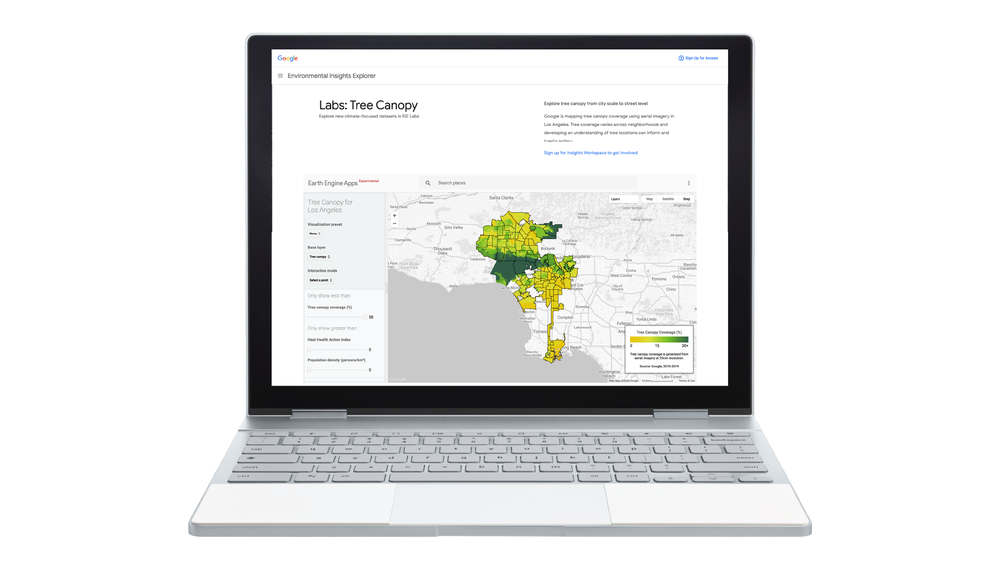Archive for November 19th, 2020
Rachel Malarich is planting a better future, tree by tree
by Alicia Cormie on Nov.19, 2020, under 3D Models, Argentina, Australia, Brazil, California, Denmark, England, Germany, Google Earth, Google Earth News, Google Earth Tips, Google Sky, Google maps, Hawaii, Indonesia, Ireland, Italy, Japan, Kenya, Mexico, Natural Landmarks, Netherlands, Sightseeing, Street Views, USA
Everyone has a tree story, Rachel Malarich says—and one of hers takes place on the limbs of a eucalyptus tree. Rachel and her cousins spent summers in central California climbing the 100-foot tall trees and hanging out between the waxy blue leaves—an experience she remembers as awe-inspiring.
Now, as Los Angeles first-ever City Forest Officer, Rachel’s work is shaping the tree stories that Angelenos will tell. “I want our communities to go to public spaces and feel that sense of awe,” she says. “That feeling that something was there before them, and it will be there after them...we have to bring that to our cities.”
Part of Rachel’s job is to help the City of Los Angeles reach an ambitious goal: to plant and maintain 90,000 trees by the end of 2021 and to keep planting trees at a rate of 20,000 per year after that. This goal is about more than planting trees, though: It’s about planting the seeds for social, economic and environmental equity. These trees, Rachel says, will help advance citywide sustainability and climate goals, beautify neighborhoods, improve air quality and create shade to combat rising street-level temperatures.
To make sure every tree has the most impact, Rachel and the City of Los Angeles use Tree Canopy Lab, a tool they helped build with Google that uses AI and aerial imagery to understand current tree cover density, also known as “tree canopy,” right down to street-level data. Tree inventory data, which is typically collected through on-site assessments, helps city officials know where to invest resources for maintaining, preserving and planting trees. It also helps pinpoint where new trees should be planted. In the case of LA, there was a strong correlation between a lack of tree coverage and the city's underserved communities.
With Tree Canopy Lab, Rachel and her team overlay data, such as population density and land use data, to understand what’s happening within the 500 square miles of the city and understand where new trees will have the biggest impact on a community. It helps them answer questions like: Where are highly populated residential areas with low tree coverage? Which thoroughfares that people commute along every day have no shade?
And it also helps Rachel do what she has focused her career on: creating community-led programs. After more than a decade of working at nonprofits, she’s learned that resilient communities are connected communities.
“This data helps us go beyond assumptions and see where the actual need is,” Rachel says. “And it frees me up to focus on what I know best: listening to the people of LA, local policy and urban forestry.”
After working with Google on Tree Canopy Lab, she’s found that data gives her a chance to connect with the public. She now has a tool that quickly pools together data and creates a visual to show community leaders what’s happening in specific neighborhoods, what the city is doing and why it’s important. She can also demonstrate ways communities can better manage resources they already have to achieve local goals. And that’s something she thinks every city can benefit from.
“My entrance into urban forestry was through the lens of social justice and economic inequity. For me, it’s about improving the quality of life for Angelenos,” Rachel says. “I’m excited to work with others to create that impact on a bigger level, and build toward the potential for a better environment in the future.”
And in this case, building a better future starts with one well planned tree at a time.
Creating new tree shade with the power of AI and aerial imagery
by Nicole Lombardo on Nov.19, 2020, under 3D Models, Argentina, Australia, Brazil, California, Denmark, England, Germany, Google Earth, Google Earth News, Google Earth Tips, Google Sky, Google maps, Hawaii, Indonesia, Ireland, Italy, Japan, Kenya, Mexico, Natural Landmarks, Netherlands, Sightseeing, Street Views, USA
Most of us have heard the timeless proverb, "The best time to plant a tree was 20 years ago. The second best time is now.” Worldwide, there is growing discussion in cities about planting more trees as policymakers and neighbors look to increase shade on warming city streets.
Extreme temperatures are becoming more common in cities where concrete and infrastructure are now creating heat islands—areas that experience higher temperatures, leading to poor air quality, dehydration and other public health concerns. Trees are increasingly seen as a solution to both lowering street-level temperatures while improving quality of life. Yet many cities may not have the budget or resources to locate where every tree in town is, or where new tree-planting efforts are most needed.
With our new Tree Canopy Lab we are combining AI and aerial imagery to help cities see their current tree canopy coverage and plan future tree planting projects, starting with the City of Los Angeles.
With the Tree Canopy Lab you can see Los Angeles’s trees with local context, like what percentage of a neighborhood has leafy cover, an area’s population density, what areas are vulnerable to extreme heat, and which neighborhood councils can help get new roots in the ground.
Tree Canopy lab is in our Environmental Insights Explorer platform, a tool that makes it easier for cities to measure, plan and reduce carbon emissions and pollution. It’s also one step forward in part our commitment to help hundreds of local governments fight climate change.

Anyone can access the Tree Canopy Lab from a tablet or personal computer
Mapping tree cover to seed new urban forestry efforts
With aerial imagery collected from planes during the spring, summer and fall seasons, as well as Google AI and Google Earth Engine’s data analysis capabilities, we can now pinpoint all the trees in a city and measure their density. The imagery we use for these calculations includes color photos that closely represent how we would see a city from the sky. To get even more detailed information about the city’s canopy cover, near-infrared photos detect colors and details that human eyes can’t see and compare images from different angles to create a height map.

See tree cover in Los Angeles with Tree Canopy Lab
We then use a specialized tree-detection AI that automatically scans the images, detects the presence of trees and then produces a map that shows the density of tree cover, also known as “tree canopy.”
With this tool, the City of Los Angeles doesn’t have to rely on expensive and time-intensive manual tree studies which can involve block-by-block tree surveys, outdated records, or incomplete studies which only count trees in public spaces.
From policymakers to neighbors, anyone can explore Los Angeles in the Tree Canopy Lab and glean insights. For example, the lab can help anyone identify residential blocks with high tree planting potential and locate sidewalks that are vulnerable to higher temperatures due to low canopy coverage.

Tree Canopy Lab's AI scans aerial images, detects the presence of trees and then produces a map that shows the density of tree cover
With Tree Canopy Lab we’ve found that more than 50 percent of Angelenos live in areas with less than 10 percent tree canopy coverage and 44 percent of Angelenos live in areas with extreme heat risk. We also see a correlation that shows parts of Los Angeles with the lowest heat risk also have the highest tree canopy coverage — these areas are also the lowest population density of Angelenos.
Connecting cities with new environmental insights
Los Angeles has been on the forefront of cities using urban forestry to not only advance sustainability goals, but to beautify neighborhoods, improve air quality and bring down street-level temperatures as the region gets hotter due to climate change.
With a near-term goal of planting and maintaining 90,000 trees by 2021 and continuing to plant trees at a rate of 20,000 per year across a city of more than 503 square miles, the Tree Canopy Lab is already helping people across the city reach this goal. From neighbors and community organizations to Mayor Eric Garcetti and the city’s first-ever forestry officer, Rachel Malarich, they all have access to a birds-eye view of where the city’s existing trees are and which areas need more greenery.
“Every tree we plant can help stem the tide of the climate crisis, and when we expand our urban forest, we can sow the seeds of a healthier, more sustainable and equitable future for communities hit hardest by rising temperatures and intensifying heat waves. Google’s technology will help us bring the power of trees to families and households across Los Angeles -- adding greenery to our public spaces, injecting beauty into our city, and bringing cooler temperatures to our neighborhoods.”
-Mayor of Los Angeles, Eric Garcetti
More tree insights for more cities on the horizon
We’ll be making the insights in Tree Canopy Lab available to hundreds of more cities in the year to come as we continue to support the ambitious work cities like Los Angeles are doing to embark on tree planting and maintenance initiatives.
We invite city planners and policymakers to reach out to kickstart a conversation with us sharing their interest through this form.